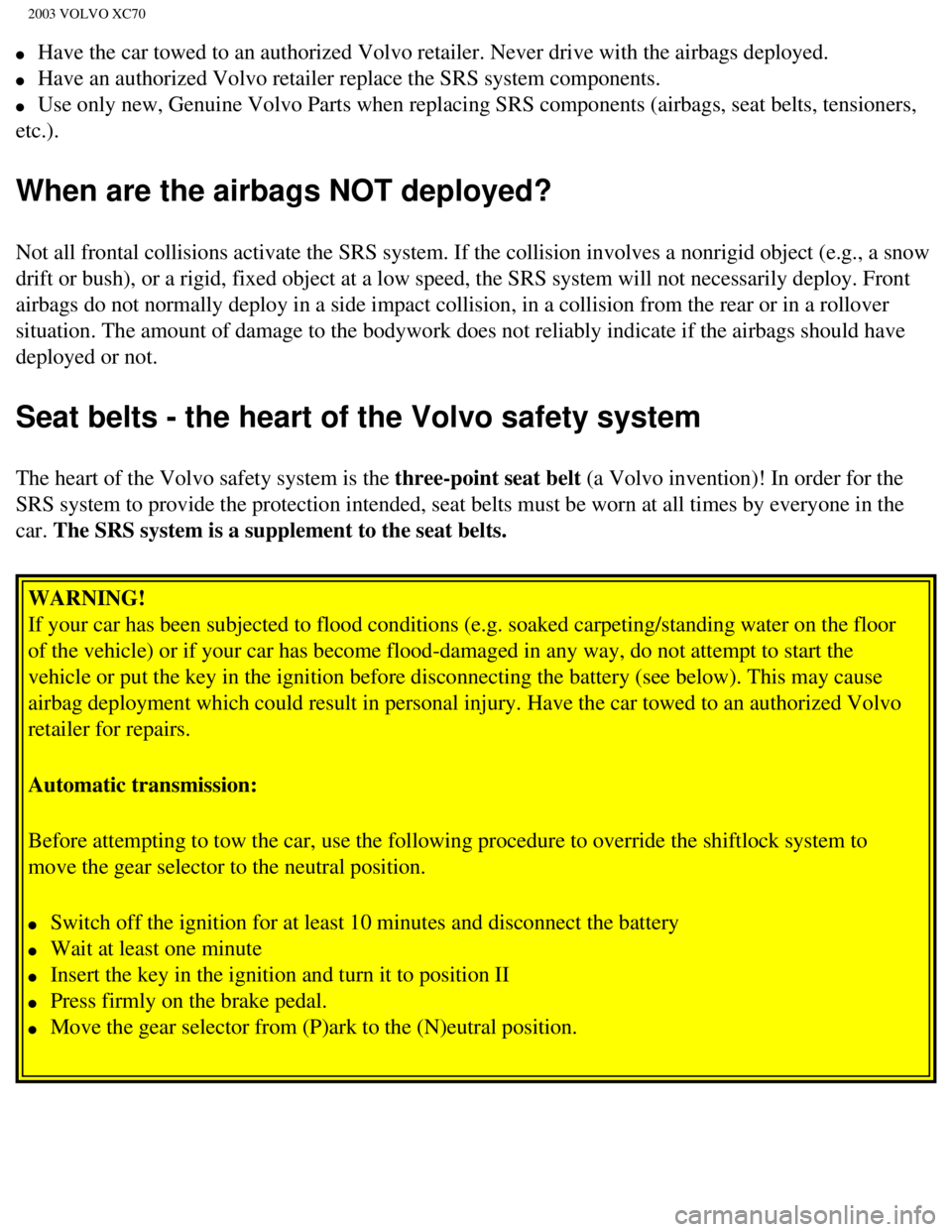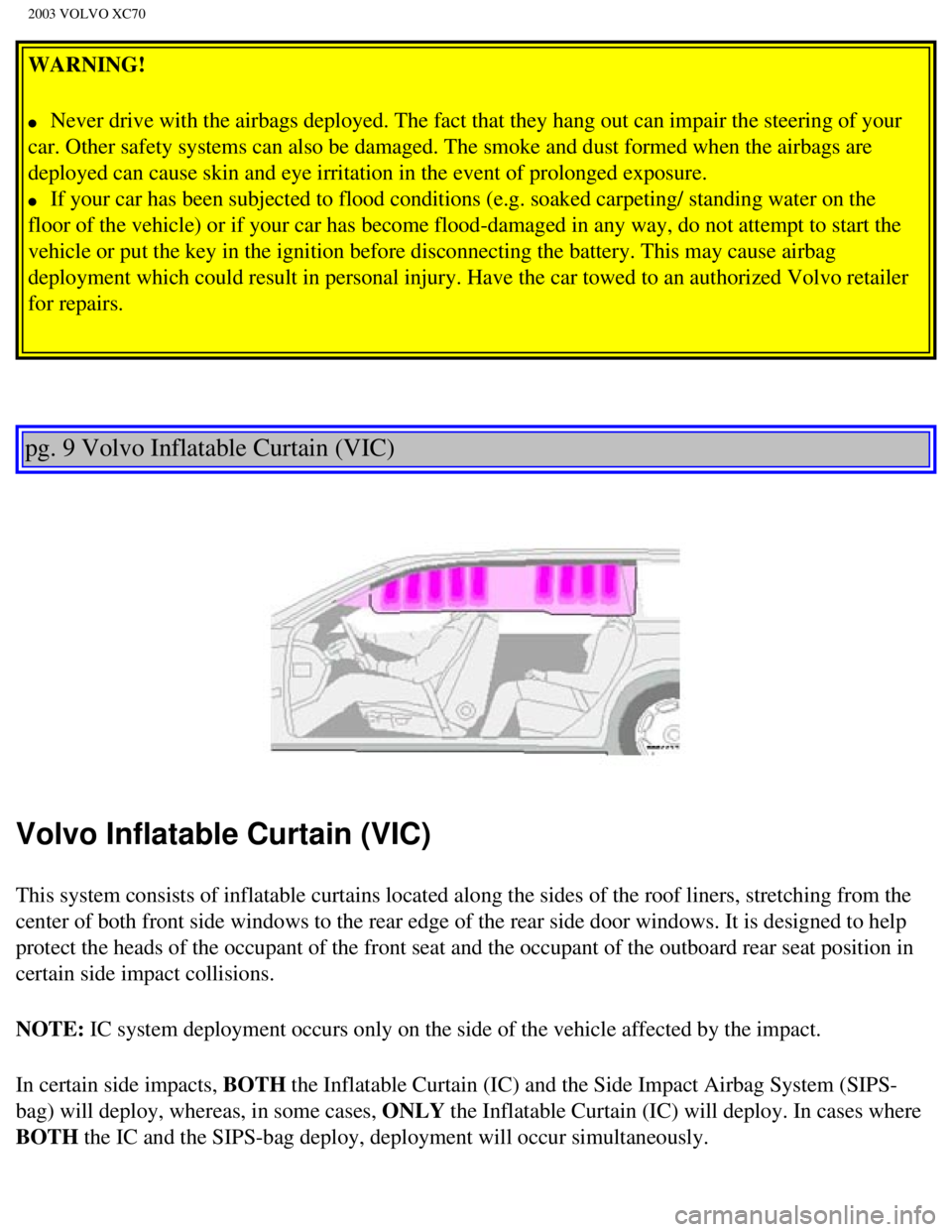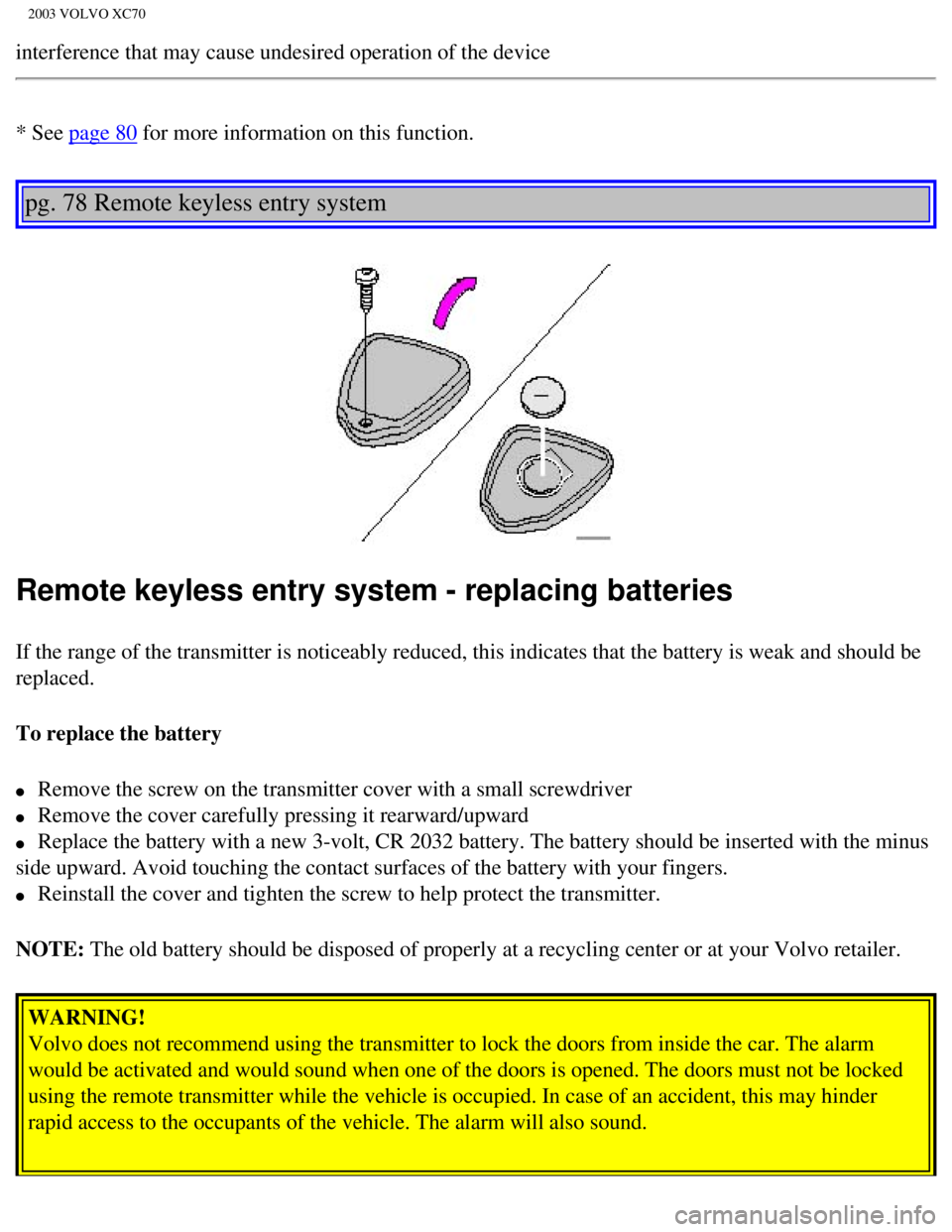2003 VOLVO XC70 battery
[x] Cancel search: batteryPage 17 of 257

2003 VOLVO XC70
l Have the car towed to an authorized Volvo retailer. Never drive with the\
airbags deployed.
l Have an authorized Volvo retailer replace the SRS system components.
l Use only new, Genuine Volvo Parts when replacing SRS components (airbag\
s, seat belts, tensioners,
etc.).
When are the airbags NOT deployed?
Not all frontal collisions activate the SRS system. If the collision inv\
olves a nonrigid object (e.g., a snow
drift or bush), or a rigid, fixed object at a low speed, the SRS system\
will not necessarily deploy. Front
airbags do not normally deploy in a side impact collision, in a collisio\
n from the rear or in a rollover
situation. The amount of damage to the bodywork does not reliably indica\
te if the airbags should have
deployed or not.
Seat belts - the heart of the Volvo safety system
The heart of the Volvo safety system is the three-point seat belt (a Volvo invention)! In order for the
SRS system to provide the protection intended, seat belts must be worn a\
t all times by everyone in the
car. The SRS system is a supplement to the seat belts.
WARNING!
If your car has been subjected to flood conditions (e.g. soaked carpeti\
ng/standing water on the floor
of the vehicle) or if your car has become flood-damaged in any way, do \
not attempt to start the
vehicle or put the key in the ignition before disconnecting the battery \
(see below). This may cause
airbag deployment which could result in personal injury. Have the car to\
wed to an authorized Volvo
retailer for repairs.
Automatic transmission:
Before attempting to tow the car, use the following procedure to overrid\
e the shiftlock system to
move the gear selector to the neutral position.
l Switch off the ignition for at least 10 minutes and disconnect the batte\
ry
l Wait at least one minute
l Insert the key in the ignition and turn it to position II
l Press firmly on the brake pedal.
l Move the gear selector from (P)ark to the (N)eutral position.
file:///K|/ownersdocs/2003/2003_XC70/03xc70_01a.htm (11 of 17)12/30/20\
06 4:17:51 PM
Page 20 of 257

2003 VOLVO XC70
WARNING!
l Never drive with the airbags deployed. The fact that they hang out can i\
mpair the steering of your
car. Other safety systems can also be damaged. The smoke and dust formed\
when the airbags are
deployed can cause skin and eye irritation in the event of prolonged exp\
osure.
l If your car has been subjected to flood conditions (e.g. soaked carpeti\
ng/ standing water on the
floor of the vehicle) or if your car has become flood-damaged in any wa\
y, do not attempt to start the
vehicle or put the key in the ignition before disconnecting the battery.\
This may cause airbag
deployment which could result in personal injury. Have the car towed to \
an authorized Volvo retailer
for repairs.
pg. 9 Volvo Inflatable Curtain (VIC)
Volvo Inflatable Curtain (VIC)
This system consists of inflatable curtains located along the sides of t\
he roof liners, stretching from the
center of both front side windows to the rear edge of the rear side door\
windows. It is designed to help
protect the heads of the occupant of the front seat and the occupant of \
the outboard rear seat position in
certain side impact collisions.
NOTE: IC system deployment occurs only on the side of the vehicle affected by \
the impact.
In certain side impacts, BOTH the Inflatable Curtain (IC) and the Side Impact Airbag System (SIPS-\
bag) will deploy, whereas, in some cases, ONLY the Inflatable Curtain (IC) will deploy. In cases where
BOTH the IC and the SIPS-bag deploy, deployment will occur simultaneously.
file:///K|/ownersdocs/2003/2003_XC70/03xc70_01a.htm (14 of 17)12/30/20\
06 4:17:51 PM
Page 100 of 257

2003 VOLVO XC70
An extra roof lamp is fitted at the end of the cargo area.
Holder for grocery bags (option)
Open the tailgate. Hang or secure your grocery bags by means of tensioni\
ng straps or holders. To
remove the plastic tray (option), turn the two knobs at the sides.
Auxiliary 12 Volt socket in cargo area (option)
Fold down the cover when you want to use the electric socket.
NOTE: The socket is live whether the ignition is switched on or off. Using th\
e socket without the
engine running can drain your car's battery.
pg. 68 Securing cargo
file:///K|/ownersdocs/2003/2003_XC70/03xc70_04b.htm (9 of 21)12/30/200\
6 4:17:57 PM
Page 117 of 257

2003 VOLVO XC70
interference that may cause undesired operation of the device
* See page 80 for more information on this function.
pg. 78 Remote keyless entry system
Remote keyless entry system - replacing batteries
If the range of the transmitter is noticeably reduced, this indicates th\
at the battery is weak and should be
replaced.
To replace the battery
l Remove the screw on the transmitter cover with a small screwdriver
l Remove the cover carefully pressing it rearward/upward
l Replace the battery with a new 3-volt, CR 2032 battery. The battery shou\
ld be inserted with the minus
side upward. Avoid touching the contact surfaces of the battery with you\
r fingers.
l Reinstall the cover and tighten the screw to help protect the transmitte\
r.
NOTE: The old battery should be disposed of properly at a recycling center or\
at your Volvo retailer.
WARNING!
Volvo does not recommend using the transmitter to lock the doors from in\
side the car. The alarm
would be activated and would sound when one of the doors is opened. The \
doors must not be locked
using the remote transmitter while the vehicle is occupied. In case of a\
n accident, this may hinder
rapid access to the occupants of the vehicle. The alarm will also sound.\
file:///K|/ownersdocs/2003/2003_XC70/03xc70_05.htm (5 of 11)12/30/2006\
4:17:58 PM
Page 119 of 257

2003 VOLVO XC70
Central locking buttons
Central locking buttons
These buttons (located on the both front door armrests) can be used to\
lock/unlock all doors and the
tailgate and set the alarm.
The rear passenger doors can also be locked and unlocked with the indivi\
dual lock buttons on each door.
pg. 80 Alarm
Alarm
The alarm is automatically armed whenever you lock your car. When armed,\
the alarm continuously
monitors a number of points on the car. The following conditions will se\
t off the alarm:
l The hood is forced open.
l The tailgate is forced open.
l A door is forced open.
l The ignition switch is tampered with.
l If there is movement in the passenger compartment (if the car is equipp\
ed with the optional movement
sensor).
l The car is lifted or towed (if the car is equipped with the optional in\
clination sensor).
l The battery is disconnected (while the alarm is armed).
Arming the alarm
Press the LOCK button on the remote control, lock the car using the key \
in the driver's door or press the
central lock button on one of the front doors with the door open. One lo\
ng flash of the turn signals will
confirm that the alarm is armed.
file:///K|/ownersdocs/2003/2003_XC70/03xc70_05.htm (7 of 11)12/30/2006\
4:17:58 PM
Page 120 of 257

2003 VOLVO XC70
Disarming the alarm
Press the UNLOCK button on the remote control or unlock the doors with t\
he key.
Turning off (stopping) the alarm
If the alarm is sounding, it can be stopped by pressing the UNLOCK butto\
n on the remote control or by
unlocking the driver's door with the key.
Visual alarm signal
The visual alarm signal is given by flashing all turn signals and turnin\
g on the interior lighting for
approximately 5 minutes.
Audible alarm signal
An audible alarm signal is given by a battery powered siren. One alarm c\
ycle lasts for 25 seconds.
"Panic" button
In an emergency situation, this feature can be used to attract attention\
. Activate the "panic" function by
pressing the red button on the remote control (see illustration on
page 77) for at least 3 seconds or by
pressing this button twice within 3 seconds. The turn signals will flash\
, the interior lights will go on and
the car's horn will sound.
The function can be turned off by pressing any of the buttons on the rem\
ote control or will stop
automatically after 25 seconds. When a button is pressed, there is a 5 s\
econd delay before the
panic alarm is deactivated.
NOTE: This function will NOT unlock the car.
pg. 81 Alarm
file:///K|/ownersdocs/2003/2003_XC70/03xc70_05.htm (8 of 11)12/30/2006\
4:17:58 PM
Page 142 of 257

2003 VOLVO XC70
Electrical system
When replacing the battery or when carrying out work involving the elect\
rical system, the following
should be observed:
l A battery connection to the wrong terminal will damage the electrical sy\
stem. Be sure to connect the
positive battery cable to the positive battery terminal and the negative\
battery cable to the negative
battery terminal.
l If booster batteries are used for starting, they must be properly connec\
ted to minimize the risk of the
electrical system being damaged. For correct connection, see "Jump start\
ing" section.
l Never disconnect the battery circuit (for example, to replace the batte\
ry) while the engine is running,
as this may damage the generator. Always make sure that all the battery \
connections are properly
cleaned and tightened.
l If any electrical welding work is performed on the vehicle, the battery'\
s ground lead (negative cable)
and all the connecting cables of the generator must be disconnected and \
the welder cables placed as near
the welding points as possible.
l The radio must be turned off before the battery is disconnected.
l Switch off the ignition for at least 10 minutes before disconnecting the\
battery.
pg. 97 Roof racks/Load carriers
Load carriers (accessory)
Load carriers are available as Volvo accessories. Observe the following \
points when in use:
l To avoid damaging your car and to achieve maximum safety when driving, w\
e recommend using the
load carriers that Volvo has developed especially for your car.
l Volvo-approved removable roof racks are designed to carry the maximum al\
lowable roof load for this
vehicle: 220 lbs (100 kg). For Non-Volvo roof racks, check the manufac\
turer's weight limits for the rack.
l Never exceed the rack manufacturer's weigh limits and never exceed the m\
aximum rated roof load of
220 lbs (100 kg).
l Avoid single-point loads. Distribute loads evenly.
l Place heavier cargo at the bottom of the load.
l Anchor the cargo correctly with appropriate tie-down equipment.
l Check periodically that the load carriers and load are properly secured.\
l Remember that the car's center of gravity and handling change when you c\
arry a load on the roof.
l The car's wind resistance (and correspondingly, fuel consumption) will\
increase with the size of the
load.
l Drive smoothly. Avoid rapid starts, fast cornering and hard braking.
file:///K|/ownersdocs/2003/2003_XC70/03xc70_06a.htm (19 of 22)12/30/20\
06 4:18:00 PM
Page 147 of 257

2003 VOLVO XC70
Rear towing eyelet
Precautions when the car is in tow
l The steering wheel must be unlocked. Turn the ignition key to position I\
or II.
l The gear selector must be in position N.
l Maximum speed: 50 mph (80 km/h)
l Maximum distance with front wheels on ground: 50 miles (80 km).
l While the car is being towed, try to keep the tow rope taut at all times\
.
l Cars with an automatic transmission should only be towed in forward dire\
ction.
CAUTION:
l Please check with state and local authorities before attempting this typ\
e of towing, as vehicles being
towed are subject to regulations regarding maximum towing speed, length \
and type of towing device,
lighting, etc.
l If the car's battery is dead, do not attempt to start the vehicle by pus\
hing or pulling it as this will
damage the three-way catalytic converter(s). The engine must be jump s\
tarted using an auxiliary battery
(see
page 103).
l If the car is being towed on a flat bed truck, the towing eyelets must n\
ot be used to secure the car on
the flat bed. Consult the tow truck operator.
WARNING!
l Remember that the power brakes and power steering will not function when\
engine is not running.
The braking and steering systems will function but the brake pedal press\
ure required is 3 - 4 times
above normal and greater steering effort must be exerted.
l The towing eyelets must not be used for pulling another vehicle out of a\
ditch or for any similar
purpose involving severe strain.
l Do not use the towing eyelets to pull the car up onto a flat bed tow tru\
ck.
pg. 100 Vehicle towing information
file:///K|/ownersdocs/2003/2003_XC70/03xc70_06b.htm (2 of 10)12/30/200\
6 4:18:00 PM